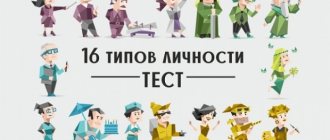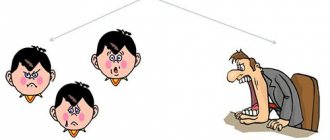Communicating with the people around us, it is easy to notice that we are all different. This is an obvious truth. However, while remaining unique individuals with their own individual characteristics, people may have similar traits, qualities, and characteristics. Even ancient philosophers made attempts to classify representatives of the human community, uniting them into groups according to some common characteristics.
But it is almost impossible to create a comprehensive classification, since people can be grouped according to different criteria: characteristics of emotionality, social status, level of intelligence, interests, goals, etc. In the 20th century, with the development of psychological science, the classification of types of people began to focus on characteristics of their inner world, that is, the psyche, and the concept of “psychotype” appeared. Currently, there are many psychological typologies, and we will introduce you only to the most popular ones.
What is a psychotype
Any person represents a unity of the general and the individual. Recognizing the right of everyone to be a bright and unique personality, we must understand that the laws by which the psyche works are common to everyone, which means there are many similarities between people. This allows psychologists to draw general conclusions and develop effective and applicable methods of psychotherapy and correction to all individuals.
But along with general and individual traits, there are also typical ones, that is, they allow people to be united into groups (types) based on some common characteristics. In this case, we will talk about psychological characteristics and, accordingly, psychotypes. A psychotype is a complex of mental characteristics that make up a generalized model of human behavior and his reactions to external stimuli. These patterns are characteristic of many people, which allows them to be grouped together.
Why are such classifications needed? Psychologists need them to use different approaches to working with clients according to their types. However, too general methods and advice are not always effective, and it takes a lot of time to understand the individual “cockroaches” of each person. It’s easier to start from typological features and start analyzing individual problems and choosing work methods from them.
Here's an example. According to the characteristics of contacts with the outside world, all people can be divided into two types: extroverts and introverts:
- Extroverts are open to the world and other people and draw their energy from outside themselves.
- Introverts are closed in their inner world; they have difficulty building relationships with others and focus on their own resources.
It is clear that in order to develop the correct strategy for communication and interaction with a client, a psychologist needs to know what type he is.
It is also useful for ordinary people to know about their own psychotype. Such information allows you to interact with the world more effectively and avoid many mistakes. That is, knowledge of psychotypes is a useful thing, and special tests have been developed to determine them.
True, there is one problem: there are so many different typologies, classifications and their descriptions that it is not easy for even a psychologist to understand them. Therefore, I will introduce you only to the most popular ones.
Psychotypes according to Oldham-Maurice
This psychologist-researcher proposed his classification of people’s psychotypes:
- conscientious;
- self-confident;
- devoted;
- dramatic;
- vigilant;
- sensitive;
- adventurous;
- hermit;
- altruistic;
- aggressive;
- serious.
A conscientious personality type always strives to do the job perfectly and often suffers from perfectionism. Pays attention to small details, thinks through the solution to the issue several times, and always achieves his goals.
Self-confident types are ambitious individuals aimed at moving up the career ladder. They are competitive, active and efficient. But excessive self-confidence and thirst for praise can play a cruel joke on them and turn colleagues and friends away from them.
The loyal personality type is a very sweet, sociable person who does not have his own opinion or initiative. These are obedient performers who can always be entrusted with doing important work. But without the guidance and guidance of “seniors in rank” they are not capable of anything. This position also greatly interferes with one’s personal life.
The dramatic type has dynamic emotionality, is constantly in the center of events and is interested in the latest news. Negative character traits are: the desire to be irresistible and to dramatize events.
The vigilant type sees a catch and a double bottom in everything. This is a negative component of character. In general, these people are self-sufficient, independent, careful and extremely careful.
The sensitive type does not like changes in surroundings and emotional outbursts. It is important for them to be in a familiar environment among trusted people. They have difficulty making contact with new people and do not open their souls to the open.
The adventurous type is guided by their own benefit, for the sake of which they can resort to deception and forgery. Determined people easily take any risk. Impulsiveness is their hallmark.
For hermits, solitude is the best state of mind. They love peace, quiet and contemplation. Hermits are indifferent to the world around them and do not share its interests.
The altruistic type is capable of self-sacrifice for the sake of the interests of other people. They always show concern for their neighbors, are not conflicting and are not malicious.
The aggressive type lives up to its name by being excessively demanding of others and outright cruelty. They are not afraid of difficulties, easily take responsibility and show persistence in achieving their goals.
The serious type always thinks about any step and is in no hurry to make decisions on important issues. A negative quality is self-examination and low self-esteem.
Types of temperament according to Hippocrates
The oldest and at the same time the most famous classification of personality types was developed more than 2,500 thousand years ago by the ancient Greek philosopher and healer Hippocrates. I think everyone knows about this typology, but I’ll start with it. Firstly, out of respect for the discoverer, and secondly, because many modern classifications are based specifically on types of temperament.
So, according to Hippocrates, all people are divided into 4 types depending on the fluid prevailing in their body:
- Sanguines. For this type of people, the leading role is played by blood (“sangva” in ancient Greek). Therefore, they are very energetic, active, persistent in achieving their goals, irreconcilable and often cruel. Sanguine people are excellent warriors and leaders.
- Cholerics. Their body is dominated by bile (in ancient Greek - “holi”), so they are extremely fickle, fussy, talkative and emotional. They are characterized by frequent mood swings, imbalance and the inability to focus on one thing for a long time.
- Melancholic people. Their predominant black bile (“melena holi”) makes them gloomy, sad people, constantly in a depressed mood. People of this type are touchy, but sensitive and capable of sympathy and empathy.
- Phlegmatic people. Thanks to the mucus (“phlegm”) that dominates their body, they are sedentary, uncommunicative, self-absorbed, often in a thoughtful state and incapable of strong emotions.
It has now been proven that temperaments do not exist in their pure form, although Hippocrates’ observations are generally correct. It’s just that each of us has individual qualities of different types of temperament. As a rule, there are more of some of them, but it happens that individual properties of all temperaments are present almost equally. Therefore, in modern psychology, it is the individual qualities of temperaments that are isolated and studied. For example, the level of emotionality, the level and nature of sociability, stability or, on the contrary, variability of the psyche, etc.
Attitudes of consciousness of extroverts and introverts
The general attitude of consciousness differs between introverts and extroverts. The first type of people is characterized by studying their own inner world and this prevails over communication with society. The second type of people, on the contrary, tries to pay more attention to objective reality.
The personality type that resembles extroverts has become more entrenched in society. Because of this, introverts are misunderstood and called selfish, but this is an erroneous judgment. No one can understand the world perfectly objectively - neither society nor an individual.
Due to the pressure of society on introverts, their differences from the majority, such people often live feeling the weight of guilt on themselves, which has a bad effect on their psychological development, condition
Types of higher nervous activity according to I. P. Pavlov
Russian psychophysiologist I.P. Pavlov confirmed the correctness of Hippocrates' classification, but he, of course, did not believe that the types were associated with fluid in the body. The difference in temperaments or types of higher nervous activity, from Pavlov’s point of view, depends on the strength, nature and speed of the basic nervous processes - excitation and inhibition. The psychophysiologist also identified 4 types, whose characteristics are very close to the temperaments of Hippocrates:
- Strong, fast - sanguine.
- Strong, inert – phlegmatic.
- Strong, unrestrained - choleric.
- The weak type is melancholic.
It was the study of the characteristics of higher nervous activity of different types made by I. P. Pavlov that made it possible to identify such characteristics of individuals as extraversion and introversion, emotional stability and lability, rigidity and plasticity, etc. Combinations of these characteristics formed the basis of many modern classifications, including one of the most popular – the classification of psychosociotypes.
Sensory typology of personality
Psychosociotypes
The psychosociotype of a personality is an innate mental structure. The identification of psychosociotypes is based on the personality typology developed by K. Jung and later modified by Myers and Briggs. According to this criterion, people can be divided into types according to the following characteristics:
1) extraversion - introversion;
2) thinking type (logician) – emotional type (ethicist);
3) feeling type (sensory) – intuitive type (intuit);
4) rationality - irrationality.
According to their personality, C. Jung divides people into extroverts (outward-facing) and introverts (inward-facing), i.e. this pair characterizes the source of energy and its expression. Extroverts are sociable, active, optimistic, mobile, they have a strong type of higher nervous activity, by temperament they are sanguine or choleric, most often the leading hemisphere is the right. Introverts are uncommunicative, reserved, separated from everyone, their actions are guided mainly by their own ideas, they take decision making seriously, and control their emotions. Introverts include phlegmatic and melancholic people. In introverts, the leading hemisphere is the left.
The thinking type - the emotional type - characterizes the personality from the position of decision-making. Objectivity and impartiality are inherent in the thinking type of personality, subjectivity and interpersonality are inherent in the emotional type.
The thinking type is characterized by the desire to understand and explain the essential features and patterns of life events. For the emotional type, the main thing is to express one’s attitude towards an event, evaluate the event, accept or reject it.
The characteristics of the sensory-intuitive pair show how a person collects information about the world: verbatim and sequentially or more figuratively and arbitrarily. The sensory (sensing) type is characterized by the acceptance of events “as reality,” as a fact, as a sensory experience (sensation, perception). The intuitive type is characterized by the ability to predict the future development of events and is characterized by imagination.
The characteristics of the pair rationality - irrationality are applicable to the analysis of an individual’s lifestyle: certainty, methodicality, and planning are inherent in the rational type of personality; impulsiveness, life without shackles, taking information into account - irrational.
Sensory typology of personality
The sensory typology is based on the leading channel for receiving and reproducing information, determined by the type of analyzer. In accordance with this feature, visual, auditory and kinesthetic personality types are distinguished.
For the visual type, all perceived information is presented in the form of bright pictures, visual images. When telling something, these people often gesticulate, as if drawing imagined images in the air. In conversation they often use the phrases: “Here, look…”, “I clearly see that…”. When remembering what they need, these people look straight ahead, up, left, or up right.
The auditory type is characterized by the use of words “I hear what you are saying”, “It sounds like this...”, etc. When remembering, the gaze is turned to the right, left or left down.
People of the kinesthetic type remember sensations and movements well. When remembering, these people first recreate and repeat the movements and sensations of the body. When remembering, they look down or down to the right. In conversation, they mainly use kinesthetic words: “take”, “grasp”, “feel”, “heavy”.
Requirements for a management decision
Due to the special significance and importance of management decisions, responsibility for the correctness of their adoption and implementation, each management entity must ensure compliance with the following requirements (principles):
feasibility - the decision must be linked to the general goals and objectives solved by the organization, with the concept and concepts of strategic interests, taking into account the specific socio-political and economic situation;
optimality – choosing from several solution options the one that will lead to the most desired result in the shortest way and at the lowest cost;
reality - lies in the need to proceed from:
– timeliness
– adequate response of the subject and objects of management to a dynamically changing situation;
– objectivity
– accurate knowledge and correct assessment by the manager (employee) of the situation;
– specificity
– the actions of the subject of management must include the choice of a very specific option of action, as well as a clear formulation in the description of these actions, the distribution of role responsibilities of the decision makers, the determination of the spatial and temporal framework of the adopted option of action;
flexibility - the ability to make appropriate changes to the finished version of the management decision, which, as a rule, take into account general and specific trends in the development of the situation;
taking into account the primary and derivative consequences of decisions made and implemented, which affect even years later;
consistency - comprehensive consistency with both internal and external circumstances, as well as with previous and upcoming decisions;
eligibility , i.e. reliance on the requirements of legal acts, regulations, instructions and orders of managers, as well as taking into account the responsibilities and rights of management and subordinates;
efficiency – best results and minimal costs;
form of presentation of a management decision (oral or written) - provision to the performer of sufficient information that does not require additional clarifications and explanations, brevity and clarity of presentation of the essence of the decision.
Thus, the development and adoption of management decisions are a specific prerogative of management activities, its main function and the most difficult task.
№23.
There are several stages in the structure of the management decision-making process: identification of a problem situation, its analysis, formulation of alternatives, their evaluation, selection of an alternative, implementation of the decision, control and correction. Such a normalized structure can be represented in the form of a “decision ring”.
According to A.V. Karpov, the very definition of a problem situation presupposes a diagnosis of the “situational zone”, that is, a diagnosis with the help of which the answer to the initial questions can be given: what do we have; what needs to be achieved; What are the difficulties of moving from what is available to what is desired?
Analysis of the content of the problem involves determining and analyzing the content of the problem situation, i.e. awareness and identification of its symptoms (for example, low profits, very high production costs, conflicts, staff turnover), and the development of basic requirements (criteria) that will form the basis for the selection of certain alternatives.
This stage involves working with the information necessary to study the characteristics of the situation and identify those factors that influence decision making.
The formulation of alternatives includes a search and identification of possible solutions to a problem situation. If there is only one alternative, then it should neither be accepted nor rejected; it is necessary to try to formulate other alternatives.
The assessment of alternatives (“weighing of alternatives”) is carried out in accordance with the formulated criteria and goals of the activity, as well as taking into account the parameters of the dynamic environment. The difficulties that the management subject has to face at this stage lie in determining the number of alternatives and the criteria for their selection.
The selection of options for the decision to be made is carried out on the basis of the following criteria: effectiveness (degree of approach to a given goal) and availability of execution (availability of forces, means, capabilities).
Selection, justification and formulation of the optimal solution . Once the range of possible options has been identified, it is necessary to evaluate each alternative and determine which one best contributes to resolving the situation. The main normative principle of this stage is the maximization postulate: one should choose the alternative that maximizes the possible gain and at the same time minimizes the expected loss or losses.
If the optimal solution is not found, the manager can: postpone the decision for some time; break the problem into stages; make a partial decision that will allow work to begin; apply the “least worst” rule, i.e. choose the best solution from the available bad options.
The management decision made is first of all expressed orally, followed by its written confirmation. As a rule, decisions for the most part are expressed in certain documents.
The implementation of the decision is the period of organizing the activities of the decision makers.
The necessary conditions for the successful implementation of a management decision are created during the period of its preparation and adoption. Therefore, the decision must already provide for who, where, when and how to perform this or that task. All these elements create the necessary organizational prerequisites for the implementation of management decisions. The very organization of execution (implementation) of a management decision can be divided in spatial and temporal relations by objects (groups of objects), by tasks and time intervals.
To perform each of the designated groups, employees with appropriate qualifications (experience) and level of authority are selected.
Then specific tasks or fragments of the decision made should be communicated to the performers.
A serious problem associated with organizational effectiveness is the implementation of decisions made. Up to a third of all management decisions do not achieve their goals due to low performance culture. The degree of implementation of decisions made can be increased by working to improve their rationality (not all decisions are feasible), improving executive discipline, including ordinary employees in the development of solutions, motivating such activities, and organizing control over execution.
Execution control involves obtaining information about the implementation of management decisions and performance results. The essence of control is to compare the results obtained with those that were formulated as expected at the stage of assessing the initial problem of the situation. In case of their discrepancy, a correction of the management decision is carried out, which consists of a timely revision of decisions in accordance with the changing conditions of their implementation or the nature of official activities. Among the reasons requiring changes and additions to an already made decision, there may be serious errors in the initial management decision.
The main mistakes when making decisions: postponing the decision until there is no time left for preparation (rash decision); turn a blind eye to the possible consequences of a decision or not think about them at all; as a criterion, focus only on yourself and your own benefit and not worry about other consequences (egocentric decision); decide only by inspiration; decide on the basis of sympathies, moods, discarding all rational considerations (emotional decision); rely on the sound advice of other people in full confidence in one’s infallibility; not wanting to learn from your mistakes; make the same decisions.
Knowing mistakes allows you to avoid undesirable consequences in preparing and making management decisions.
№24.
The phenomena that arise in the processes of making management decisions really influence both the process of making decisions and its effectiveness. The main of these phenomena are the following:
1. The effect of reactance in selection. If a person is strongly recommended to choose this or that alternative, to carry out this or that action, then reactance arises - not to do exactly this.
2. Ceiling effect. Most often, a decision is made at the level of risk offered by the most “risky” member of the organization.
3. The effect of deforming the thinking of individuals developing a collective decision. The mechanism of suggestion lies at the heart of the deformation of thinking.
4. Volume effect. Groups that are too small and too large in size (number of people) are characterized by less efficiency in decision making. The optimal volume, according to experimental data from psychologists, is a group of 4–8 people.
5. Effect of group composition. The most homogeneous and the most heterogeneous groups produce less effective solutions. It is necessary to recruit groups with average homogeneity of its members.
6. The phenomenon of leadership, manifested in situations: illusory hypertrophied trust in the leader; avoidance of leadership; false consent (conformism); the effect of demonstrative disagreement. This effect is opposite in nature to the previous one. It manifests itself in the desire of individual group members to “stand out”, to emphasize their role and the false “independence” of judgments without the proper basis for this and professional competence.
7. The phenomenon of psychological inertia, which consists in the fact that the formulation of the problem evokes a certain stereotype in memory and sets a person up for a certain thought process, and he can no longer change his mind.
8. The phenomenon of protective inhibition, which consists in the fact that after some time of intensive mental work and with a negative outcome of solving the problem, the thought begins to work more and more slowly, completely stops generating new options, repeating the same thing.
9. The phenomenon of age-related changes, the essence of which is that with age a person becomes more careful, more circumspect, and more afraid of decisions that could lead to a change in the existing situation.
№25.
The decision-making process is closely related to modeling and, in essence, is one. Modeling is a form of implementation of decision-making methods, the content of which is an algorithm (process) for developing a solution, i.e. a set of operations and procedures performed in a certain sequence and leading to the desired result.
Analytical methods for making management decisions
According to the degree of formalization of the decision process and the presentation of its results, analytical (quantitative, formalized) solution methods are distinguished, used in solving well-structured problems, in which the dependencies between the elements of the situation have numerical values, and qualitative (non-formalized) methods (models) of management decisions, where the dependencies between the elements of the management task have qualitative characteristics. Formalized ones include graphical modeling, mathematical modeling, simulation modeling and experimentation.
Graphic modeling is a reflection of objects and processes in an organization in the form of graphs, diagrams, diagrams, etc. One of the popular methods of making management decisions used to select the best course of action from changing options is the “decision tree” method.
The decision tree method is a diagrammatic representation of a decision-making problem. This method allows the manager to consider different courses of action, relate financial results to them, adjust them according to the probability assigned to them, and then compare alternatives. In management practice, graphical vector optimization tools are used.
Mathematical modeling is used in relation to those objects and processes, the characteristics and connections of which can be assessed quantitatively; most often this refers to resource management and their effective use. Mathematical models are presented in the form of various kinds of equations, relationships, etc.
The main types of economic and mathematical models used in the practice of managing enterprises and organizations are: analytical (functional and statistical, including correlation and regression); prognostic; mathematical programming; queuing; inventory management; models.
Simulation modeling, unlike previous types, reflects the behavior of objects in dynamics, in real time. In simulation models (including mathematical ones), at the request of the person carrying out the modeling, not only variables, but also model parameters can be changed. Numerous models have been created that simulate the behavior of various economic entities in market conditions, the performance of individual organizational management functions (marketing, planning, logistics, sales, etc.), the functioning of individual production divisions of the enterprise, etc.
Experiment – modeling on real objects. It is used to test solutions to problems (hypotheses) developed by other modeling methods. This is the most expensive type of modeling; it should be resorted to in cases where the possibilities of other types of modeling have been exhausted.
In management practice, the most effective is the integrated use of various types of modeling. However, this is only possible with the availability of modern means of supporting decision-making processes. These tools find their most vivid expression in expert systems - special human-machine systems that, based on the use of databases and knowledge about a specific object, depending on the specified operating conditions, offer various options for solving problems.
Heuristic methods for solving management problems
Heuristic methods for solving management problems are a system of principles and rules that set the most probabilistic strategies and tactics for the decision-maker, stimulating his intuitive thinking in the decision process, generating new ideas and, on this basis, significantly increasing the efficiency of solving management problems of a certain class.
One of the common methods of group solving management problems is the method of “brainstorming” - brainstorming, proposed by the American scientist G. Osborne. Research has revealed the fact that the quantity and quality of alternative ideas increases when the initial generation of ideas is separated from the final formulation. The discussion takes place in two stages; At the first level, there are “idea generators” whose task is to put forward as many proposals as possible, even the most fantastic and at first glance unacceptable. At the second stage, the initiative passes to the “critics,” whose role is to analyze the ideas expressed, select “rational grains” and develop a new solution based on them or determine the best alternative. This course of discussion is fruitful because it creates a creative atmosphere, allows you to avoid critical analysis of ideas immediately after they are expressed, and thereby overcome the constraint caused by a possible negative reaction from the participants in the discussion.
The success of the method largely depends on the discussion leader (or session leader, as he is usually called), who prohibits criticism of the ideas proposed by the participants and encourages all kinds of remarks, jokes, and directs the course of the discussion by asking stimulating questions.
The number of participants is usually 4–15 people; a group of 7 to 13 people is considered the most optimal. It is desirable that the session participants be of different levels of education, different specialties, but it is recommended to maintain a balance between participants of different levels of activity, character and temperament.
The duration of the brainstorming session varies from 15 minutes to one hour.
The Delphi method, which got its name from the oracle who lived in the ancient Greek city of Delphi, is a type of brainstorming. In this case, a solution to the problem is provided in several stages.
First, as in the previous method, individual expertise is used to eliminate the influence of experts on each other. Then the management group processes the results of the examination, summarizes similar solutions, draws up a certificate reflecting opinions on the decision, and identifies significantly different opinions. Those experts whose opinions differ from the majority are asked to argue their position more deeply or reconsider it. The procedure is repeated several times until the experts’ opinions stabilize (or a unanimity of opinions is achieved). Usually three or four stages are enough.
The 635 method is also a type of brainstorming. Six participants put forward three ideas, which go to other participants, who complement them with three new ideas, and so on five times.
All ideas are recorded in writing on an ideas collection form. After passing through the hands of all six participants, the forms contain 108 ideas. Then the critics get involved.
The practice of using this method shows that ideas presented in written form are more reasonable and clear than those expressed orally, although they are often less original.
Synectics method . It was proposed by W. Gordon and literally means a combination of heterogeneous things. The essence of the method is that the discussion is started by 5-7 synectors - people identified in advance and occupying opposing positions. The group, having understood these extreme points of view, evaluates them comprehensively and makes an informed decision.
Ring method. Widely used in Japan in management decision-making practice. The term “rings” is interpreted as “obtaining consent to solve a problem through a survey without convening a meeting.”
This procedure is used to make strategic decisions, ensuring in-depth study, project alignment and creative participation of all key employees - from line positions to management. Responsibility for the decision made does not fall personally on the manager, but is distributed among all managers at various levels. In Japan, the “ringi” procedure is classified as a management philosophy that professes foresight, caution, and collective responsibility.
To the undoubted advantages
The method of group search for original ideas should be attributed to the fact that it equalizes all members of the group, since the authoritarianism of management in the process of its application is unacceptable.
The disadvantages
and limitations of the method are that its use allows one to put forward and find a creative idea in the most general form. The method does not guarantee thorough development of the idea. It is also inapplicable or has limitations in application when a management task requires large preliminary calculations and calculations.
The use of the method of group search for original ideas requires a relatively high skill of the leader, the ability to improvise, and a sense of humor. In the process of its application, it is also not always possible to overcome the inertia of thinking, since sometimes the illusion of some most probable means, method, or approach to solving a management problem is created.
The disadvantage is that a group decision contains more elements of risk than an individual decision. This phenomenon is called “risk shift.” “Group polarization” occurs and opposing points of view are clearly exposed, and the middle ones seem to cease to exist. At the same time, it is difficult to predict which of the polar positions will form the basis of the decision.
The most commonly used individual heuristic methods for solving management problems include the following methods: heuristic questions, multidimensional matrices, free associations, inversion, empathy, organized strategies.
the method of heuristic (“key”) questions to collect additional information in a problematic situation or to organize existing information in the very process of solving a creative problem. By skillfully asking questions, the difficulty of the task is reduced to an optimal level. Dignity
The method lies in its simplicity and effectiveness for solving any problems.
Heuristic questions especially develop intuition of thinking, a typical logical scheme for solving management problems. The disadvantages
and limitations of this method are that it does not provide particularly original ideas and solutions and does not guarantee absolute success in solving management problems.
Method of multidimensional matrices. This method is based on the principle of systematic analysis of new connections and relationships,
which appear in the process of matrix analysis of the problem under study.
Dignity
The method of multidimensional matrices is that it allows you to solve complex management problems and find many new, unexpected, original ideas.
Disadvantages
and the limitations of the method of multidimensional matrices may be that even when solving problems of average difficulty, the matrix may contain hundreds of possible solutions, the choice of which is optimal turns out to be difficult.
Free association method. It has been noticed that the effectiveness of creative activity, especially at the stage of generating new ideas, increases significantly if more and more new associations are widely used, which ultimately give rise to truly productive ideas.
In the process of the emergence of associations, extraordinary relationships are established between the components of the problem being solved and elements of the external world, including components of the previous experience of creative activity of persons participating in the collective solution of the problem of a management task. As a result of the process of the emergence of new associative connections, creative ideas for solving a problem arise. To strengthen anti-conformism, it is necessary that each member of the group strives to offer and offers his word, a concept that should be the basis for establishing associative connections with the process of generating new ideas.
The inversion method (in psychology it is sometimes called the inversion method) is one of the heuristic methods of creative activity, focused on finding ideas for solving a management problem in new, unexpected directions, most often opposite to traditional views and beliefs, which are dictated by formal logic and common sense.
Undoubted advantage
The inversion method is that it allows you to develop dialectics of thinking, find a way out of a seemingly hopeless situation, find original, sometimes very unexpected solutions to management problems of varying levels of difficulty.
Its shortcomings
and the limitations are that it requires a fairly high level of creativity, basic knowledge, skills and experience.
Empathy method (personal analogy method). The process of applying analogy is, as it were, an intermediate link between intuitive and logical procedures.
When applying the empathy method, it is necessary to merge with the object of research, which requires enormous fantasy and imagination; Fantastic images and ideas are activated, which leads to the removal of barriers of “common sense” and the search for original ideas.
Method of organized strategies. One of the main psychological barriers in solving management problems is the inertia of thinking and the inability of the decider to leave, abandon the most obvious method and find a new approach, a new direction in the search for solution ideas.
And even if we choose the right directions (strategies) for searching for a solution idea, fears arise that we have missed something important, perhaps a more original strategy or idea.
To a certain extent, the method of organized strategies helps to overcome the inertia of thinking.
When using it, the following decision-making strategies are possible:
1. Mentally play out, imagine the most original solution to the problem in its final version.
2. Reverse the decision, but justify why.
3. Take an original but temporary solution.
4. Analyze all possible solutions dictated by “common sense” and choose the most effective one.
5. Analyze all possible solutions that are put forward contrary to common sense, evaluate their effectiveness.
6. Look for a series of step-by-step solutions.
7. Make your final decision.
Heuristic methods can be widely used in the practice of a modern leader of any rank, in the activities of a modern manager. Conducting meetings and business games using heuristic methods (brainstorming, empathy, inversion, synectics, etc.) usually gives a lot of ideas, fundamentally new approaches to solving various types of management problems both in government and commercial activities .
№26.
Experiments have shown that in a number of cases, the level of education, length of service and work experience turn out to be less significant than the personal properties of the person making the decision.
Researchers name a number of personality traits that influence the decision-making process. The role of such factors as the creative abilities of the individual, his emotional stability, propensity to take risks, and level of aspirations is noted; self-esteem; extroversion – introversion and others.
All individual qualities are truly interconnected and closely interact with each other in decision-making processes.
One of the most famous and general classifications of stylistic differences in decision making is the identification five types depending on the relationship between the two main stages of the decision - the stage of formulating hypotheses and alternatives (A) and the stage of analysis, correction and control over them (K):
1. Inert solutions
(A << K), that is, the second stage dominates the first. The type is characterized by an uncertain and cautious search for options. Any alternatives are subject to strict control and clarification. The process is moving slowly and carefully. Estimates are super critical. Every step of the decision is questioned. Alternatives and hypotheses are poorly expressed. To a large extent they are uncreative and unoriginal.
2. Careful decisions
(A < K) are characterized by a thorough assessment of alternatives and hypotheses, and an abundance of preparatory actions to collect information. This is a kind of softened version of inert solutions.
3. Balanced decisions
(A = K) are characterized by a peculiar harmony of the main types of components of the management decision process. The alternatives and hypotheses here are quite qualitative and variable. The control of alternatives is quite pronounced. This option allows us to develop the most reliable solutions.
4. Risky decisions
(A
>
K) are characterized by a certain dominance of the phase of alternatives and hypotheses over the phase of control and correction.
When analyzing alternatives, the emphasis is on their positive aspects. The maximum result can be achieved by decisions containing
justified risk.
5. Impulsive decisions (A >> K).
Alternatives and hypotheses here dominate the stage of their verification, correction and control
.
Characterized by excessive categorical assessments and judgments. Solutions here are the most risky and least effective, which often leads to irreversible consequences. This type of decision is typical for people with poor reflexivity, low self-control and high self-esteem.
Another classification developed by A.I. Kitov and has a less general, but at the same time more specific character in relation to management activities, includes eight main personal decision profiles:
1. Motivational-passive profile
characterized by weak professional competence of the manager, lack of a long-term program, and weak interest in achieving high results.
2. Profile “imitation of vigorous activity”
characterized by formally high activity, little correlated with the real problems that arise in the leadership process. Excessive control and “pushing” subordinates is a characteristic feature of a leader with this profile. It is focused not on the interests of the group, but on the decisions of a higher authority.
3. General management profile.
Here the leader is business-oriented. However, this orientation is very specific. He is not involved in organizing the execution of decisions, but is only limited to the formulation of tasks, incentives for execution, pressure on subordinates and strong control.
4. Frustration profile
characterized by the fact that at the first stage of decisions there is high intellectual activity, a sincere desire to understand the essence of the matter and its problems. However, combined with insufficient competence, all this faces insurmountable difficulties. As a result, the leader goes into a state of frustration. And as a result, there may be a refusal to solve the problem, shifting it to the performers. This, in turn, often leads to tension, even to conflicts along the “manager – subordinates” vertical. This profile is contraindicated for management activities!
5. Profile of a tense, unsuccessful search to the end.
This profile is typical for rigid (inflexible) type leaders with limited intelligence, but high volitional potential and high self-esteem. The very first stereotypical decision is taken as the most successful and correct one, after which ways of putting this decision into practice are sought. Reckoning is a confrontation with insurmountable difficulties.
6. Profile of a formally correct, but not rational solution.
This profile is ineffective, although to some extent it is quite reliable. It is characterized by insufficient originality of the leader's thinking, combined with clarity of leadership and strict control.
7. Heuristic profile combined with underdeveloped organizational skills.
Here, the high intellectual qualities of the leader are combined with insufficiently developed organizational abilities. It is easier for a leader to find an original solution himself than to organize others for this, to mobilize them to solve the problem.
8. Heuristic-organizational profile.
This is a kind of ideal of a leader, which is quite rare in practice. Such a leader quickly analyzes the problem, grasps the essence of the issue, clearly formulates the hypothesis and objectives, quickly makes a decision and persistently implements it. Such a leader combines high intellectual potential with developed organizational skills, which allows, if necessary, to flexibly reconsider the tactics of finding a solution to a problem.
In connection with the considered personal profiles of decisions, it is of interest to study the behavior patterns of a leader in the decision-making process with the participation of subordinates in it. American scientists V. Vroom and F. Yetten identify five models of behavior:
Al – the manager makes a decision independently, using the information available to him (self-decision);
A2 – the manager receives information from subordinates, then solves the problem independently. Subordinates act only as a source of information, and the manager may not tell them why he needs it (information search);
K1 – the manager reports the occurrence of a problem to the relevant subordinates, finds out from each
Previous1Next
C. Jung's theory and psychosociotypes of personality
The main criterion of this typology is individual differences in the exchange of information between a person and the social environment. K. Jung, one of the followers of S. Freud, was more interested not in sexual, but in social problems of people. From his point of view, all individuals differ in how they interact with the world, or more precisely, with society. Their behavior depends on the characteristics of this interaction, which manifests itself very early, since the differences are innate. In total, K. Jung identified 4 types, in each of them paired and opposite characteristics of people appear:
- Extroverted and introverted types. The differences between them are related to the energy source. Extroverts receive it from the outside world, mainly from the people around them. Introverts come from internal reserves.
- Sensory and intuitive. They differ in the features of collecting and processing information. The first type focuses on real data from the senses; it is important for him to see, touch, and evaluate everything. And the second type trusts their intuition more.
- According to the nature of decision-making, all people are divided into an emotional-sensual type and a thinking-logical type. The first type lives and acts at the behest of feelings, while the second prefers deliberate actions according to a strictly developed plan.
- Lifestyle features determine the fourth difference between the types. The perceiving (emotional) type lives “spontaneously”, goes with the flow, he is flexible, easily adapts and changes his behavior. The decisive (rational) type prefers to make independent decisions, is not inclined to obey the will of others and often goes ahead. But at the same time, he clearly knows what his goal is and what is needed to achieve it.
Currently, based on the theory of K. Jung, a simplified typology is more often used, dividing all people into 4 types according to the nature of perception and processing of information:
- thinking;
- sensory;
- emotional;
- intuitive.
The characteristics of these types can combine to produce a wide variety of personalities and behaviors. For example, an extrovert may have both a sensory-sensing and an intuitive type of perception of information. And an introvert can belong to both the emotional-sensual and the thinking-logical type. All combinations of characteristics are absolutely normal, although sometimes they seem “wrong” if you belong to a different type.
Basic socionic types
Jung owns a classification of 8 main psychotypes, on the basis of which socionics proposed a more detailed classification consisting of 16 psychotypes.
- Logical-intuitive extrovert (LIE), “Jack London”, “Entrepreneur”. He is able to clearly identify his own capabilities and abilities, is easily inspired and starts new things, and is interested in dynamic sports that give extreme sensations. Feels new trends, takes risks, relying on intuition. Confidently uses new technologies in her work, deeply analyzes herself and the world around her. Inclined to positive thinking and close communication with people.
- Logical-sensory extrovert (LSE), “Stirlitz”, “Administrator”. A very efficient, socially adapted type, he always feels the need to bring the work he has started to completion. Plans activities and treats surrounding things practically. Tends to show love and care for loved ones, loves noisy fun and company. He is good-natured, but harsh, can be hot-tempered and stubborn.
- Ethical-intuitive extrovert (EIE), “Hamlet”, “Mentor”. A very emotional person, prone to empathy and displaying a wide range of emotions. He has expressive facial expressions and eloquence. Able to anticipate various events and prepare for them in advance. Picks up inconsistencies in other people's words and emotions. Often unsure of a partner's love and prone to jealousy.
- Ethical-sensory extrovert (ESE), “Hugo”, “Enthusiast”. Able to influence people through emotional pressure, he gets along well with them, can cheer them up, is inclined to sacrifice his own interests for the sake of another person and show love and care for loved ones. In his work he achieves everything on his own, loves when other people emphasize his merits.
- Logical-intuitive introvert (LII), “Robespierre”, “Analyst. He knows how to distinguish the important from the secondary, does not like empty talk, and is prone to clear, practical thinking. In their work, this type likes to use unusual ideas, while demonstrating their independence. Uses intuition where he does not know the exact answers. Does not like noisy companies, finds it difficult to establish relationships with other people.
- Logical-sensory introvert (LSI), “Maxim Gorky”, “Inspector”. Loves order and rigor, delves deeply into work, analyzing information from different angles. It is distinguished by a certain pedantry. He looks at things realistically and takes on a task only if he knows for sure that he can complete it. Inspires trust, but prefers short business contacts with other people.
- Ethical-intuitive introvert (EII), “Dostoevsky”, “Humanist”. He subtly senses the nature of relationships between people, attaches great importance to trust, and does not forgive betrayal. He is able to identify the hidden abilities of others and is endowed with the talent of an educator. He is passionate about self-education, people often turn to him for advice. We are very vulnerable, it is difficult to tolerate aggression and lack of love.
- Ethical-sensory introvert (ESI), “Dreiser”, “Guardian”. Recognizes pretense and falsehood in relationships, divides people into friends and strangers, managing psychological distance. He defends his views and principles. He knows how to stand up for himself and his loved ones, and cannot tolerate the moral superiority of other people. Able to deeply analyze himself and others.
- Intuitive-logical extrovert (ILE), “Don Quixote”, “Seeker”. He has a wide range of interests, knows how to adapt to new conditions and easily switches to new methods of work. He is a generator of ideas and does not like traditions and routine. Able to explain complex ideas, being a pioneer in them. He is more prone to synthesis in thinking, creates a new idea from ready-made components.
- Sensory-logical extrovert (SLE), “Zhukov”, “Marshal”. Tends to use physical force in order to achieve victory at any cost. Obstacles only increase his desire to win. Likes to lead and cannot stand being subordinated. Analyzing the situation, he likes to draw up a specific plan of action and strictly follows it.
- Intuitive-ethical extrovert (IEE), “Huxley”, “Adviser”. He is able to subtly feel other people and has a developed imagination. Loves creative work and cannot stand monotony and routine. Sociable, likes to give practical advice in the field of interaction with people.
- Sensory-ethical extrovert (SEE), “Napoleon”, “Politician”. Able to see the capabilities of others, using this knowledge for the purpose of manipulation. Guides the weaker ones, clearly identifying their weak points. He likes to keep his distance; in communication he is more likely to be guided by his own interests. In the eyes of others he tries to look like an outstanding, original person, but often he is not.
- Intuitive-logical introvert (OR), “Balzac”, “Critic”. This type is an erudite with a philosophical mindset. He is careful, makes a decision only with confidence in its correctness, analyzing the vulgar in its connection with the future. Does not like violent manifestations of emotions, appreciates coziness and comfort.
- Sensory-logical introvert (SLI), “Gaben”, “Master”. Sensations are for him the main source of knowledge of the world. Shows empathy, subtly feels and loves other people, rejects artificiality and falsehood. He is distinguished by a technical mindset, loves to work with his hands, while always meeting the required deadlines.
- Intuitive-ethical introvert (IEI), “Lyric”, “Yesenin”. A dreamy and lyrical person, he knows how to intuitively predict events, has a good understanding of people, loves and “feels” them. He has a good sense of humor and wins the affection of other people. This type attaches great importance to appearance. He doesn’t know how to save money, and while working he likes to rest for a long time.
- Sensory-ethical introvert (SEI), “Dumas”, “Mediator”. Knows how to enjoy ordinary life, calmly enduring monotony and routine. Gets along easily with people, respecting their personal space, while demanding the same attitude from them. Likes to joke, entertain, avoids conflict situations. He is often a helper and loves to feel needed and significant in the eyes of other people.
Nowadays, developed technologies make it possible for everyone, without exception, to undergo testing and find out their socionic types, but we should not forget that a person’s personality is very multifaceted and ambiguous, therefore only a professional psychologist can qualitatively compose and describe a socio-psychological portrait of a personality during multi-level psychological diagnostics , where socionics is one of the methods.
Popular theory
The founder of the first theory about personality psychotypes is considered to be C. Jung
.
Many people know this classification as the definition of phlegmatic, choleric, melancholic and sanguine. But the theories that cover more types are considered the most complete and complex. One of them is built on as many as 16 personality psychotypes
, each of which is characterized by its own external signs and behavioral characteristics.
Attitudes towards sex in people with different types of character: psychology
You can build a successful business with people of a high-toned type of character in psychology; they love children very much; among other things, they have an interesting attitude towards sex. If a person is in apathy, he clearly has no time for sex. In fear, a person is afraid of everything, including sex. Hidden hostility and sex are total debauchery, betrayal, complete nonsense.
In anger, sex is used to punish another. In boredom, sex becomes important as it has many health benefits. Sex should be had three times a week according to the correct ritual and in an acceptable position - this is the attitude of conservatives.
As for enthusiasm, there is a very interesting topic going on. He is very interested in people of the opposite sex. At the same time, life in general is an extremely exciting and entertaining thing for such people. He manages to be happy even in family life and such people have something to do at night with their significant other.
Therefore, such individuals are very faithful and permanent partners. Also the sexual energy that every person has and it is this energy that encourages sexual intercourse. So, for enthusiasts, it is processed (sublimated) into creative energy. It rises from the lower chakras to the upper ones and the person will receive a powerful surge of energy for creativity.
Creative energy is needed to create something new, cool, and effective. This is not some obscure artist who paints piles of garbage. This guy creates his life, makes it better, and because of this, everything around him improves. It is these people who reach powerful heights.
Our defense industry in Russia, all these Zircons, Armatas and so on, were made by just such people. Due to their enormous creative potential, they discover new things in science and technology. And they make the country’s defenses such that not a single asshole will interfere. Computer games are one thing, and real guys who can stand up for themselves are quite another.
It is also important to understand how this type of person differs from temperament. It's actually simple. Mood is what a person experiences inside. And temperament is how this internal state manifests itself on the outside











